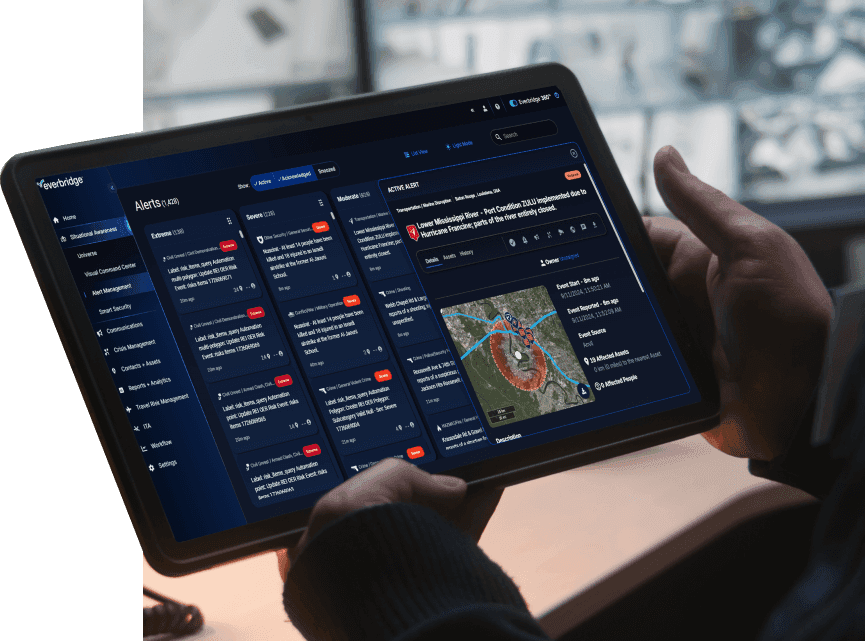Discover the full business value of critical event management
Although the benefits of deploying Critical Event Management (CEM) are becoming widely accepted, organizations can often struggle to demonstrate the tangible ROI to their key stakeholders, and can face an uphill battle when it comes to securing budget.
So, is it possible to put a value on Critical Event Management? To answer this question, Everbridge commissioned global market research firm, Forrester Consulting, to conduct an updated Total Economic Impact™ (TEI) Study, and examine the return on investment enterprises realized by deploying Everbridge’s CEM platform.
To understand the benefits, costs, and risks associated with this investment, Forrester interviewed six representatives from four organizations with experience using CEM. For the purposes of the study, Forrester aggregated the interviewees’ experiences and combined the results into a single composite organization that is a global manufacturing firm with $16 billion in revenue and 30,000 employees. The purpose of the study is to provide organizations with a framework to evaluate the potential financial impact of CEM.
For more information, access the study and other resources such as an ROI calculator that can generate a fully customized report revealing the business value CEM can bring to your organization.
Five quantifiable benefits of Everbridge
The 2023 study revealed five quantifiable benefits of Everbridge, and several others that while unquantifiable, provided benefits to organizations.
1. Reduced business interruptions led to $3 million in efficiency gains
For the composite organization, the use of Everbridge reduced the downtime caused by business interruptions, resulting in up to $3 million in efficiency gains over three years. With CEM, organizations can react faster to unplanned interruptions and outages, communicate with appropriate stakeholders faster, and overall decrease the impact of a critical event.
2. Reduced IT downtime saved up to $2 million
Not only does the Everbridge platform reduce the potential impact on business operations, but it also decreases the costs associated with IT downtime. The TEI study found that with Everbridge, organizations can save up to $2 million over three years. Increasingly complex IT environments require intelligent solutions that help identify and alert responders to outages as they happen. With improved workflows and automated processes, IT teams can quickly join forces to remediate incidents and reduce downtime.
3. Increased security team productivity gains $1.5 million
Before Everbridge, security teams overwhelmingly relied on manual and often time-consuming processes to identify and assess potential events. When using our CEM platform however, the same organization gained 24/7 support, and efficiencies in managing data sources and communicating with appropriate stakeholders.
4. Avoided inventory and property damage saved $1.1 million
Without proactive tools, organizations rely on manual processes to identify upcoming events that threaten inventory and property. However, with Everbridge, intuitive data sets and feeds ensure that organizations can know about threats early, send alerts to those who may be potentially impacted, and avoid avertable damage.
5. Recaptured employee productivity saved $800,000+
When events are imminent, there’s no time to spare when alerting employees and other internal stakeholders. Before Everbridge, organizations lost significant time trying to get in touch with the right people, at the right time. With our resilience platform however, employee productivity is recaptured, with faster response management and coordination, totaling $861,000 over three years.
The ROI of Everbridge CEM
Based on the analysis of customer feedback and quantified benefit, cost, risk, and flexibility factors, Forrester determined that through using Everbridge’s CEM platform, organizations reduced the time taken to identify and remedy critical events, getting revenue-generating activities back up to speed more quickly. Overall, the Forrester study determined that the three-year risk-adjusted benefit of the Everbridge platform amounted to a total of US$8.47M with an ROI figure of 358%.
Calculate your organization’s potential ROI and receive a fully customized report
Discover the potential business value a critical event management platform can bring to your organization. With four simple inputs, our commissioned Forrester ROI calculator can generate a fully customized report revealing the quantifiable benefits that Everbridge CEM can bring to your organization. Just click on the “Configure Data” tab to input your data and download your report.
Create a quantifiable business case for Everbridge critical event management
Leveraging the Everbridge CEM platform has proven to be a game-changer for organizations seeking to enhance their resilience and respond swiftly to critical events. As highlighted in the 2023 Total Economic Impact (TEI) study, businesses using Everbridge have significantly reduced the time required to identify and address critical events, ultimately expediting the return to revenue-generating activities.
But what’s the next step for you and your organization? How can you achieve similar outcomes and maximize your ROI with Everbridge Critical Event Management? The TEI checklist is the answer, designed to guide you through the essential steps of quantifying benefits, building a compelling business case, and unlocking the full potential of Everbridge CEM.
Access the TEI checklist and complete a seven-step checklist for CSOs, GSOCs, and Security Analysts.

